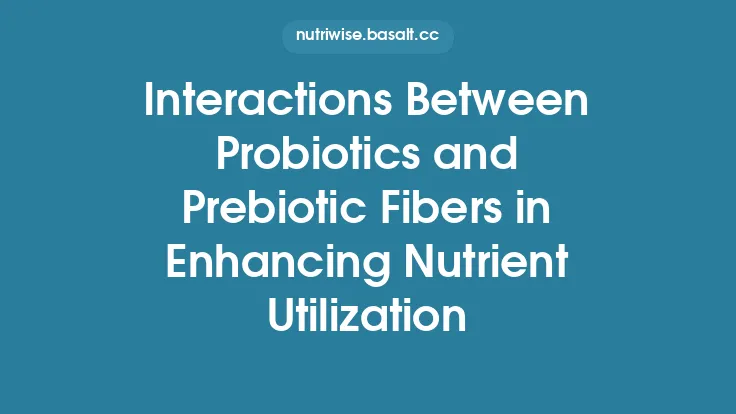Prebiotic fibers are a distinct class of dietary carbohydrates that escape digestion in the upper gastrointestinal tract and become a selective food source for beneficial members of the gut microbiota. By nurturing these microbes, prebiotics help shape a microbial community that supports efficient breakdown of nutrients, maintains the integrity of the intestinal lining, and contributes to overall digestive health. Unlike many other fiber categories that are primarily discussed in terms of physical effects (bulking, viscosity, or stool bulk), prebiotic fibers are defined by their biochemical relationship with the microbiome, making them a cornerstone of modern nutrition science.
What Are Prebiotic Fibers?
A prebiotic is formally defined by the International Scientific Association for Probiotics and Prebiotics (ISAPP) as “a substrate that is selectively utilized by host microorganisms conferring a health benefit.” In practical terms, this means that the carbohydrate must:
- Resist hydrolysis by human digestive enzymes – it reaches the colon largely intact.
- Be fermentable by specific gut bacteria – typically members of the Bifidobacterium and Lactobacillus genera, among others.
- Result in a measurable benefit to the host – such as improved nutrient absorption, enhanced barrier function, or modulation of immune signaling.
Prebiotic fibers are therefore a subset of dietary fiber, but not all fibers meet the selectivity criterion. Their primary role is metabolic rather than mechanical; they act as “fuel” for microbes that, in turn, produce compounds that influence the host’s digestive physiology.
Key Types of Prebiotic Fibers and Their Sources
| Prebiotic Type | Chemical Structure | Representative Food Sources | Typical Daily Intake (g) |
|---|---|---|---|
| Inulin | Linear β‑(2→1) fructan with a terminal glucose | Chicory root, Jerusalem artichoke, dandelion greens, onions, garlic, leeks | 3–8 |
| Fructooligosaccharides (FOS) | Short-chain fructans (DP 3–10) | Same as inulin, plus bananas, asparagus, wheat | 2–5 |
| Galactooligosaccharides (GOS) | Galactose units linked β‑(1→4) or β‑(1→6) | Human milk (naturally), soybeans, beans, lentils | 1–4 |
| Xylooligosaccharides (XOS) | Xylose oligomers (DP 2–7) | Bamboo shoots, corn cobs, hardwoods, certain fruits | 0.5–2 |
| Arabinoxylan‑derived oligosaccharides (AXOS) | Arabinose‑substituted xylose backbone | Whole‑grain wheat, rye, barley, oats | 1–3 |
| Isomaltooligosaccharides (IMO) | α‑(1→6) linked glucose oligomers | Fermented soy products, certain honey varieties | 2–5 |
| Resistant maltodextrin (RMD) – technically a functional fiber but often classified as a prebiotic due to selective fermentation | Glucose polymers with α‑(1→4) linkages, partially hydrolyzed | Processed foods, specialty supplements (use with caution) | 5–10 |
*DP = degree of polymerization, indicating the number of monomer units in the chain.*
Each of these fibers differs in chain length, branching pattern, and degree of polymerization, which influences which bacterial species can metabolize them. For instance, Bifidobacterium adolescentis preferentially utilizes longer inulin chains, whereas Bifidobacterium longum shows higher activity on shorter FOS.
How Prebiotic Fibers Interact with Gut Microbes
- Selective Fermentation
When prebiotic fibers reach the colon, they become substrates for carbohydrate‑active enzymes (CAZymes) expressed by specific bacterial taxa. The presence of dedicated glycoside hydrolases (e.g., β‑fructofuranosidases for inulin) determines which microbes can thrive. This selectivity drives a shift in community composition toward beneficial groups, a process often termed “bifidogenic effect” because many prebiotics promote Bifidobacterium proliferation.
- Cross‑Feeding Networks
Primary degraders break down complex prebiotics into simpler sugars and metabolites that secondary fermenters can further process. For example, Bifidobacteria may hydrolyze inulin to short-chain sugars, which are then utilized by Faecalibacterium prausnitzii, a butyrate‑producing bacterium. This interdependence amplifies the overall metabolic output of the microbiome.
- Modulation of Gene Expression
Exposure to prebiotic substrates can up‑regulate bacterial genes involved in carbohydrate transport (e.g., phosphotransferase systems) and down‑regulate genes linked to pathogenic traits. Metatranscriptomic studies have shown that inulin feeding increases expression of genes for mucin degradation in commensals, suggesting a role in maintaining mucosal health.
- Influence on Microbial Metabolite Profiles
While the detailed pathways of short‑chain fatty acid (SCFA) production are covered elsewhere, it is worth noting that prebiotic fermentation yields a spectrum of metabolites—including lactate, acetate, and various organic acids—that serve as signaling molecules for host cells. These metabolites can affect epithelial ion transport, mucus secretion, and even enteroendocrine hormone release, thereby subtly tuning digestive efficiency.
Impact on Digestive Processes
Enhancing Nutrient Absorption
The microbial community fostered by prebiotics improves the breakdown of otherwise indigestible polysaccharides, releasing monosaccharides and oligosaccharides that can be absorbed in the colon. This secondary digestion contributes modestly to caloric intake and can augment the availability of micronutrients such as calcium and magnesium, which are known to be more soluble in the presence of certain microbial metabolites.
Supporting Mucosal Barrier Function
A well‑balanced microbiota stimulates the production of mucin and tight‑junction proteins by colonocytes. Prebiotic‑driven bacterial populations secrete enzymes that generate signaling molecules (e.g., indole derivatives) that reinforce the epithelial barrier, reducing translocation of luminal antigens and limiting low‑grade inflammation that can impair digestion.
Regulating Gastrointestinal Motility
Although not a primary focus of the article, it is relevant that the fermentation of prebiotic fibers produces gases (hydrogen, carbon dioxide) and osmotic gradients that can subtly influence peristaltic activity. The net effect is a smoother transit through the colon, which can prevent stasis without causing the abrupt bulk effects associated with non‑fermentable fibers.
Modulating Enzymatic Activity
Certain prebiotic metabolites act as allosteric regulators of host digestive enzymes. For instance, acetate can modulate the activity of pancreatic amylase, while lactate may influence brush‑border sucrase activity. These interactions are still under investigation but illustrate the depth of host‑microbe integration in digestion.
Incorporating Prebiotic Fibers into a Balanced Diet
- Food‑First Approach
Prioritize whole foods rich in naturally occurring prebiotics. A typical day might include:
- Breakfast: Oatmeal topped with sliced banana and a sprinkle of chicory‑root inulin powder.
- Lunch: Mixed bean salad (black beans, lentils) with chopped onions, garlic, and a drizzle of olive oil.
- Snack: A handful of raw almonds and a small serving of raw carrots (source of XOS).
- Dinner: Stir‑fried broccoli, leeks, and shiitake mushrooms served over brown rice.
- Culinary Techniques
- Gentle heating preserves the structural integrity of many prebiotics; excessive boiling can partially hydrolyze inulin, reducing its prebiotic potency.
- Fermentation (e.g., kimchi, sauerkraut) can increase the availability of certain oligosaccharides by partially breaking down complex polysaccharides, creating a synergistic effect.
- Gradual Introduction
Because prebiotic fermentation produces gases, a sudden high intake may cause bloating or flatulence. Incrementally increase consumption by 1–2 g per day, allowing the microbiota to adapt.
- Synergy with Probiotics
While the article does not focus on probiotic supplementation, pairing prebiotic‑rich meals with fermented foods that contain live cultures can enhance colonization of beneficial strains, a concept often termed “synbiotic” nutrition.
- Monitoring Intake
The recommended daily intake for prebiotic fibers varies by type but generally falls between 3–10 g. Exceeding 20 g per day may increase the risk of gastrointestinal discomfort without additional benefit.
Considerations, Safety, and Potential Side Effects
- Individual Tolerance
People with irritable bowel syndrome (IBS) or small intestinal bacterial overgrowth (SIBO) may experience heightened sensitivity to fermentable fibers. Low‑FODMAP protocols often limit certain prebiotics (e.g., inulin) to manage symptoms.
- Allergic Reactions
While rare, some individuals may react to specific plant sources (e.g., chicory) due to cross‑reactivity with related allergens.
- Interaction with Medications
Prebiotic fibers can modestly affect the absorption kinetics of oral drugs that rely on colonic uptake. Clinicians should be consulted when initiating high‑dose prebiotic regimens alongside medications with narrow therapeutic windows.
- Pregnancy and Lactation
Prebiotic intake is generally considered safe during pregnancy, and some studies suggest benefits for infant gut colonization via maternal diet. However, excessive intake should be avoided to prevent discomfort.
- Pediatric Use
Children can benefit from prebiotic fibers, but dosage should be scaled to body weight (approximately 0.5–1 g per 10 kg of body weight per day).
Current Research and Future Directions
Precision Prebiotics
Advances in metagenomics and metabolomics are enabling the design of “targeted” prebiotics that selectively stimulate specific microbial pathways. For example, engineered oligosaccharides that preferentially feed Akkermansia muciniphila—a bacterium linked to mucosal health—are under investigation.
Prebiotic‑Derived Synbiotics
Research is exploring the co‑delivery of prebiotic fibers with genetically engineered probiotic strains that possess enhanced carbohydrate‑utilizing capabilities. This approach aims to maximize colonization efficiency and functional output.
Clinical Trials on Digestive Efficiency
Recent randomized controlled trials have measured markers such as nutrient absorption coefficients, intestinal permeability (via lactulose‑mannitol tests), and postprandial glucose excursions in participants consuming defined prebiotic blends. Results consistently show modest improvements in absorption efficiency and barrier integrity, supporting the mechanistic rationale presented here.
Food Technology Innovations
Food scientists are developing novel processing methods (e.g., high‑pressure processing, extrusion) that retain or even augment the prebiotic potential of ingredients. Encapsulation technologies are also being used to protect sensitive oligosaccharides through the upper GI tract, ensuring delivery to the colon.
Regulatory Landscape
Regulatory agencies in the EU and US are refining definitions of “prebiotic” for labeling purposes, emphasizing evidence of selective utilization and health benefit. This evolving framework will influence product development and consumer education.
In summary, prebiotic fibers occupy a unique niche within the broader fiber spectrum: they are not merely structural components that bulk up stool, but dynamic substrates that cultivate a beneficial microbial ecosystem. By selectively feeding gut microbes, prebiotics enhance the host’s digestive capacity, reinforce mucosal defenses, and contribute to a balanced intestinal environment. Incorporating a variety of prebiotic‑rich foods—while respecting individual tolerance—offers a practical, evidence‑based strategy for optimizing digestive health over the long term.





